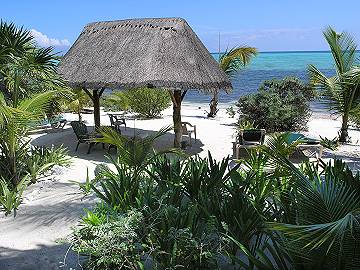Felipe Carrillo Puerto And The Mayan Riviera
One of the most beautiful places in the world, if you love the beach and the Caribbean, is the Mayan Riviera, that stretch of Quintana Roo that runs south on the Mexican Caribbean from Cancun to the Belize border. We've travelled there so many times over the years. It's a magnet for us. Given anywhere in the world to go, this is what we choose over and over again. We choose it in winter and in summer. This is what it looks like to us.

You are looking at Bahia Solimon, about 10 minutes north of Tulum, and about an hour and a half from the Cancun Airport. Bahia Solimon is an unbelievably healthy bay with a vibrant coral reef at its entrance. The Bay is ringed by about 20 homes. And you are looking at Bahia Solimon from property we are now absolutely thrilled to own. There is a page devoted to this property here, and if you want to, you can rent it by contacting locogringo.
But I digress. Quintana Roo's history is fascinating. I expect it to be the background for a new novel I've been working on. Shhhh. I do not talk about works in progress. Please forget what I just said.
There is a town in Quintana Roo called Felipe Carrillo Puerto. For many years, I thought it odd that there was a port so far inland. My misunderstanding was facilitated by road signs that persisted in saying how far it was to "Felipe Carrillo Pto", which I always read as an abbreviation for the word for "port." Alas, it turns out it's not a port. The town, originally call Chan Santa Cruz, is named for Felipe Carrillo Puerto.

Carillo was born in Motul in the Yucatan 1872. He was self educated. And became an editor of a semi monthly newspaper, which he used to denounce mistreatment of the Maya and to promote land reform and workers' rights. He was imprisoned for shooting an assassin in self defense, and he translated the constitution into Mayan while incarcerated, so that the Maya would have knowledge of the law. Eventually he was made Governor. As Governor-- he was a socialist-- he brought about extensive land reform, sought fair treatment for hennequin workers, and argued for women's rights. He appointed women to his government, something unheard of at the time. Ultimately, in 1924 he was assassinated, shot by a henchman of another politician. His last words, "No abandoneis a mis Indios!"

You are looking at Bahia Solimon, about 10 minutes north of Tulum, and about an hour and a half from the Cancun Airport. Bahia Solimon is an unbelievably healthy bay with a vibrant coral reef at its entrance. The Bay is ringed by about 20 homes. And you are looking at Bahia Solimon from property we are now absolutely thrilled to own. There is a page devoted to this property here, and if you want to, you can rent it by contacting locogringo.
But I digress. Quintana Roo's history is fascinating. I expect it to be the background for a new novel I've been working on. Shhhh. I do not talk about works in progress. Please forget what I just said.
There is a town in Quintana Roo called Felipe Carrillo Puerto. For many years, I thought it odd that there was a port so far inland. My misunderstanding was facilitated by road signs that persisted in saying how far it was to "Felipe Carrillo Pto", which I always read as an abbreviation for the word for "port." Alas, it turns out it's not a port. The town, originally call Chan Santa Cruz, is named for Felipe Carrillo Puerto.

Carillo was born in Motul in the Yucatan 1872. He was self educated. And became an editor of a semi monthly newspaper, which he used to denounce mistreatment of the Maya and to promote land reform and workers' rights. He was imprisoned for shooting an assassin in self defense, and he translated the constitution into Mayan while incarcerated, so that the Maya would have knowledge of the law. Eventually he was made Governor. As Governor-- he was a socialist-- he brought about extensive land reform, sought fair treatment for hennequin workers, and argued for women's rights. He appointed women to his government, something unheard of at the time. Ultimately, in 1924 he was assassinated, shot by a henchman of another politician. His last words, "No abandoneis a mis Indios!"






0 Comments:
Publicar un comentario
<< Home